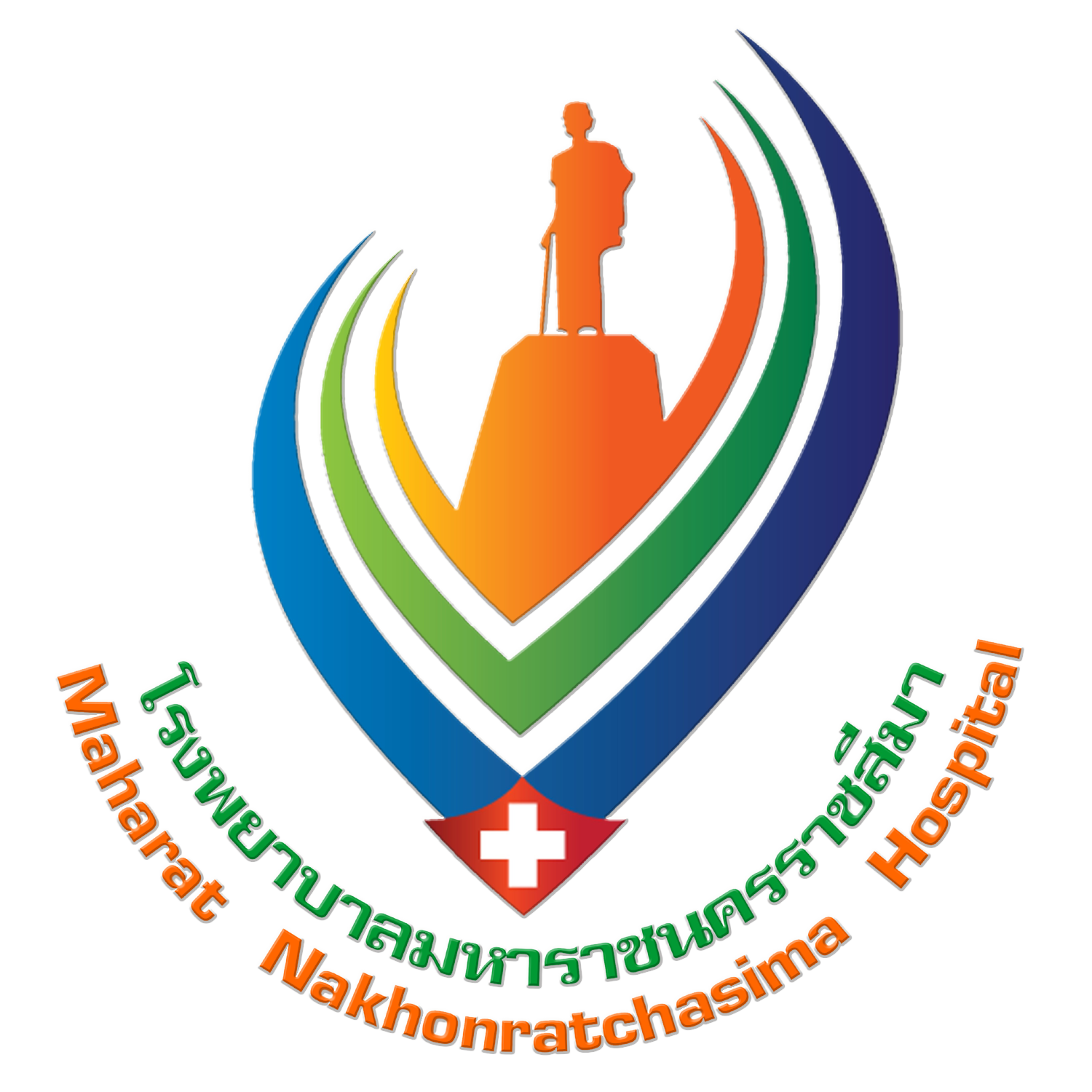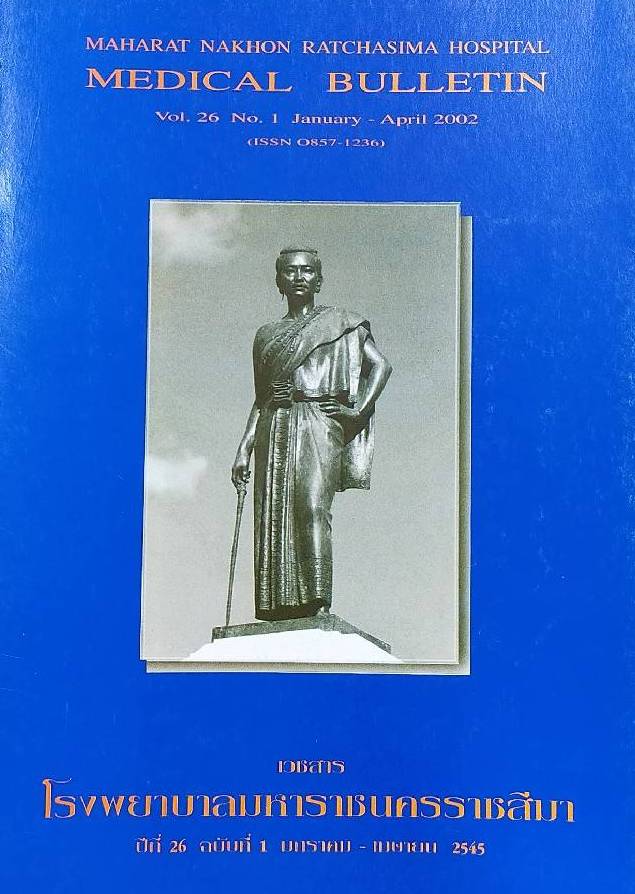การให้ยา Metronidazole 500 mg รับประทานก่อนการผ่าตัดเพื่อป้องกันการเกิดไข้ หลังการผ่าตัดมดลูกทางหน้าท้องในโรงพยาบาลมหาราชนครราชสีมา
Main Article Content
บทคัดย่อ
บทคัดย่อ:
วัตถุประสงค์: เพื่อศึกษาประสิทธิภาพในการป้องกันการเกิดไข้หลังการผ่าตัดมดลูกทางหน้าท้อง โดยการให้ยา metronidazole 500 mg รับประทานก่อนการผ่าตัด
ชนิดของการศึกษา: randomized controlled trials
สถานที่ทำการศึกษา: ภาควิชาสูติศาสตร์-นรีเวชวิทยา โรงพยาบาลมหาราชนครราชสีมา
กลุ่มตัวอย่าง: ผู้ป่วยสตรีที่เข้านอนในโรงพยาบาลเพื่อรับการผ่าตัดมดลูกแบบไม่ฉุกเฉิน ระหว่างเดือนกันยายน 2544 ถึง มกราคม 2545
วิธีการ: แบ่งกลุ่มตัวอย่างเป็น 2 กลุ่ม โดยวิธีสุ่ม กลุ่มที่ 1 มี 62 ราย ได้รับประทานยา metronidazole 500 mg ครั้งเดียว และกลุ่มที่ 2 มี 62 ราย ให้รับประทานยาหลอกก่อนการผ่าตัดไม่เกิน 8 ชั่วโมง การผ่าตัดมดลูกแบบที่ไม่ใช่มะเร็งและไม่ให้ยาปฏิชีวนะใด ๆ หลังการผ่าตัดถ้ายังไม่พบว่ามีการติดเชื้อ ติดตามประเมินผลการเกิดไข้หลังผ่าตัดและข้อมูลอื่น ๆ ที่เกี่ยวข้องนำมาวิเคราะห์ เพื่อหาความสัมพันธ์
ตัววัดทีสำคัญ: ได้แก่ ค่าเฉลี่ย (mean) ส่วนเบี่ยงเบนมาตรฐาน (standard deviation) ช่วง (range) และ Chi-square
ผลการศึกษา: กลุ่มตัวอย่างทั้งสองไม่มีความแตกต่างกันทางสถิติในด้าน อายุ ระยะเวลาการนอนรักษาตัวในโรงพยาบาล ระยะเวลาการผ่าตัด ผู้ทำการผ่าตัด ข้อบ่งชี้ในการผ่าตัด ชนิดของการผ่าตัด การได้รับเลือด และปริมาณการเสียเลือดเฉลี่ยในขณะผ่าตัด อุบัติการณ์การเกิดไข้หลังการผ่าตัดพบมีอุบัติการณ์สูงทั้งสองกลุ่ม โดยกลุ่มที่ได้รับยา metronidazole พบ 27 ราย จาก 62 ราย (ร้อยละ 43.5) และกลุ่มที่ได้ยาหลอกพบ 29 ราย จาก 62 ราย (ร้อยละ 46.8) ซึ่งไม่มีความแตกต่างกันทางสถิติ ส่วนสาเหตุการเกิดไข้พบว่ากลุ่มที่ได้รับยา metronidazole ทราบสาเหตุเพียง 6 ราย จาก 27 ราย (ร้อยละ 22.2) ส่วนกลุ่มที่ได้ยาหลอก 6 ราย จาก 29 ราย (ร้อยละ 20.7)
สรุป: อัตราการเกิดไข้หลังการผ่าตัดมดลูกทางหน้าท้องไม่แตกต่างกันทั้ง 2 กลุ่มทดลอง จากผลการศึกษาไม่มีข้อบ่งชี้ในการให้ยา metronidazole 500 mg รับประทานก่อนการผ่าตัดเพื่อป้องกันการเกิดไข้หลังการผ่าตัดมดลูกแบบไม่ฉุกเฉิน
Article Details

อนุญาตภายใต้เงื่อนไข Creative Commons Attribution-NonCommercial-NoDerivatives 4.0 International License.
เอกสารอ้างอิง
Calarke-Pearson DL, Olt GJ, Rodriguez GC, Boente MP. Preoperative evaluation and postoperative management. In: Berek JS, Adashi EY, Hillard PA, editors. Novak's gynecology. 12th ed. Baltimore: Williams & Wilkins;1999. p. 561-8.
Hager WD. Post operative infection: prevention and management. In: Rock JA, Thompson JD, editors. Te linde's operative gynecology. sth ed. Philadelphia: Lippincott Raven;1997. p. 233-1.
Di Saia PJ, Walker JL, Gold MA. Perioperative care. In: Scott JR, Di Saia PJ, Hammond CB, Spellacy WN, editors. Danforth's obstetrics & gynecology. 8th ed. Philadelpia: Lippincott Williams & Wilkins;1999. p. 703-8.
Hager WD. Postoperative infection: prevention and management. In: Schwartz SI, Shires GT, Spencer FC, Daly JM, Fischer JE, Galloway AC, editors. Principle of surgery. 7th ed. Singapore: McGraw-Hill;1999. p. 131-3.
Ledger WJ. Current problems in antibiotic treatment in obstetric and gynecology. Rev Infect Disease 1985;7 [suppl 4]: 679-9.
Hirsch HA. Prophylactic antibiotics in obstetrics and gynecology. Am J Med 1985;78 [suppl 6B]: 170-6.
Mittendorf R, Aronson MP, Berry RE, et al. Avoiding serious infections associated with abdominal hysterectomy: a meta-analysis of antibiotic prophylaxis. Am J Obstet Gyn col 1993;169:1119-24.
Tracy JW, Websten LT. Drug used in the chemotherapy of protozoal infection. In: Hardman JG, Limbird LE, Molinoff PB, Ruddon RW, Gilman AG. The pharmacological basic of therapeutics. 9th ed. New York: McGraw-Hilil;1806. p. 995-8.
Clark WG, Brater DC, Johnson AR. Pharmacokinetic characteristic of drug: Gothh's medical pharmacology.13th ed. St. Louis: Mosby Year book;1992. p. 789.
Anderson PO, Knoben JE, Troutman WG. Clinical drug data: miscellancous antimicrobials. sth ed. Stamford: Appleton & Lange;1999. p. 185-7.
Shannon MT, Wilson BA, Stang C. Health professional drug guide: metronidazole. Stamford: Appleton & Lange; 2000. p. 912-5.
ประทักษ์ โอประเสริฐสวัสดิ์. การวิจัยเชิงทดลอง. ใน: รณชัย อธิสุข, ดิฐกานต์ บริบูรณ์หิรัญสาร, พรรณเพ็ญ รัตติกาลสุขะ, บรรณาธิการ. ระเบียบวิจัย. พิมพ์ครั้งที่ 6. กรุงเทพฯ: ราชวิทยาลัยสูตินรีแพทย์แห่งประเทศไทย; 2544. หน้า 312-33.
Popkin DR, Martinez LA, Carswell GA. Metronidazole in the prophylaxis of anaerobic infections in gynecologic surgery. Surgery 1993; 93: 180-4.
Dhar KK, Dhall GI, Ayyagari A. Tinidazole prophylaxis in elective abdominal hysterectomy. Int J Gynaecol Obstet 1993;42:121-5.
Henriksson L, Frick G, Kullander S, Sandholm LE, Ursing J, Cederberg A. Metronidazole prophylaxis to prevention infection after total abdominal hysterectomy. Acta Obstet Gynecol Scand 1998;77:116-19.
Hamsell DL, Reisch J, Nobles B, Hamsell PG. Prevention of major infection after e lective abdominal hysterectomy. Am J Obstet Gynecol 1998;147:520-8.
Vincelette GR, Finkelstein F, Aoki FY, et al. Double blind trial of perioperative intravenous metronidazole prophylaxis for abdominal and vaginal hysterectomy. Surgery 1983;93(1pt 2):185-9.
Evaldson GR, Lindgren S, Malberg AS, Nord
CE. Single dose intravenous tinidazole prophylaxis in abdominal hysterectomy. Acta Obstet Gynecol Scand 1986;65:361-5.
Sutthjumroon S, Chandeying V, Tungphaisal S. Efficacy of cefoxitin in the prevention of postoperative infection in abdominal hysterectomy. Asia Oceania J Obstet Gynecol 1990;16:347-51.
สัมพันธ์ พันธุ์ทิพย์แพทย์, เมธา ทรงธรรมวัฒน์, ศรีสุดา ไทยเลิศ. การใช้ยาปฏิชีวนะเพื่อป้องกันการติดเชื้อในการผ่าตัดมดลูกทางหน้าท้องที่โรงพยาบาลอุดรธานี. วารสารการแพทย์เครือข่าย 6/2 2541:5:13-22.
อำนวย ตัณฑ์ศุภศริ, ระพี เฉลิมวุฒานนท์. ภาวะไข้ภายหลังการฝ่าตัดมดลูกทางหน้าท้องในโรงพยาบาลราชวิถี.วารสารโรงพยาบาลราชวิถี 2542;10:45-56.
Shackelf DP, Hoffman MK, Davies MF, Kaminski PF. Predictive value for infection of febrile morbidity after vaginal surgery. Obstet Gynecol 1999;93:928-31.


